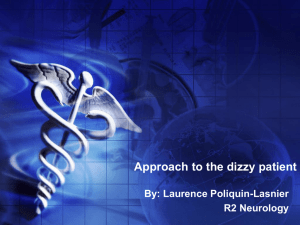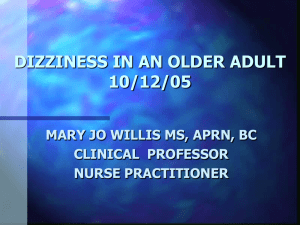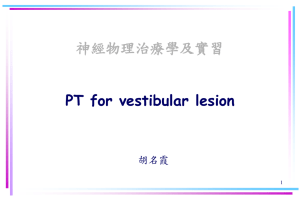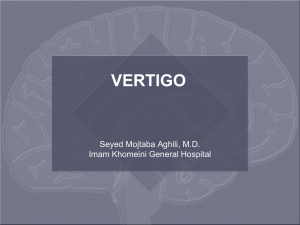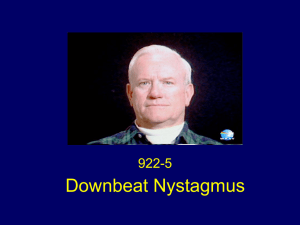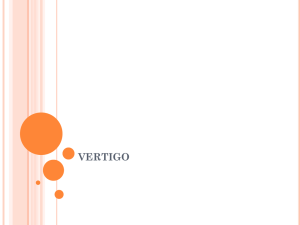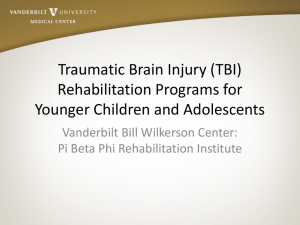VERTIGO
advertisement
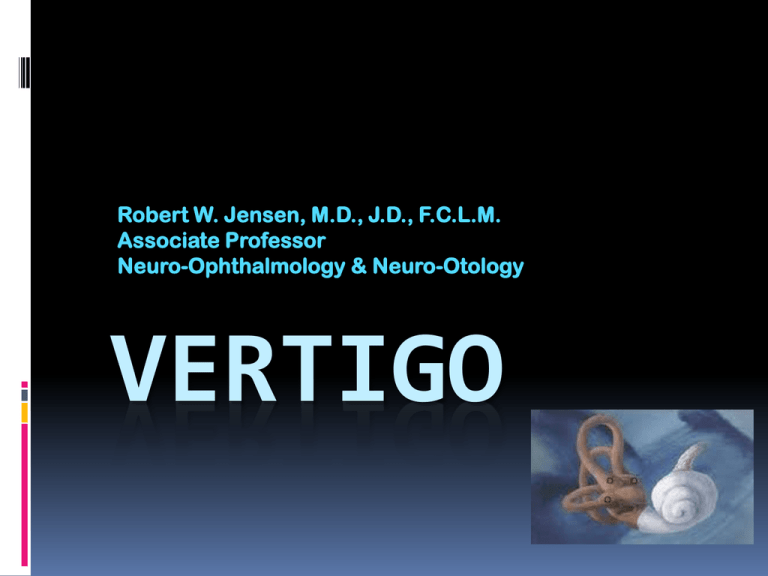
Robert W. Jensen, M.D., J.D., F.C.L.M. Associate Professor Neuro-Ophthalmology & Neuro-Otology VERTIGO What is vertigo? 1. Hallucination (believed) or Illusion (disbelieved) 2. Self (or environmental) 3. Movement a. Falling b. Spinning See-saw d. Drifting c. What is NOT vertigo Lightheaded Nauseous Weak Anxious Diplopia Blurred vision Confused Fatigued Beware the Trap ! Do not say “Dizzy.” Dizzy can mean almost anything The evaluation of dizziness often gets stuck in the mud and goes nowhere! This is because we do not clearly describe exactly what is going on. Important Points Does it come in Attacks or Spells? Is it triggered by Movement, Bending, Tilting, Rolling over, Looking up? Which way does the visual world move? Is it better if you lie or sit perfectly still? If you don’t move, does it go away? Is there hearing loss? Ear Pain? Tinnitus? Do you feel faint? Are you nauseous? TYPES OF DISEQUILIBRIUM Peripheral labyrinthine disease Vestibular nerve root disease Central vestibular disease Hypoglycemia Anxiety or Panic Hypo-perfusion Spinocerebellar degeneration Polyneuropathy or Autonomic Neuropathy Starting at the beginning … LABYRINTHINE ANATOMY The bony labyrinth consists of inter-connecting caverns within the petrous portion of the temporal bone. Perilymph = Low K (10 mEq) High Na (140 mEq) Within the bony labyrinth is the delicate membranous labyrinth “inner tube.” The membranous labyrinth fills only 25 to 45% of the bony canals. Outside the membranous labyrinth is perilymph fluid Inside the membranous labyrinth is endolymph fluid Endolymph = High K (144 mEq) Low Na (5 mEq) The endolymph circulates freely throughout the entire labyrinth, including ALL the separate sense organs, including auditory (cochlea) and vestibular (semicircular canals, utricle, and saccule) components. Vestibular and hearing organs: 1. Share the same bath water 2. Are packed in the same suitcase Semi-Circular Canals The canals contain fluid (called endolymph) The canals contain a “wind-vane” called the “cupula” that occludes a swelling called the “Ampulla” Beneath the cupula is the Crista Ampularis that contains the vestibular nerve cells Cupula sits atop the Crista Ampullaris as a gelatinous mass that completely occludes the semicircular canal at the Ampullary swelling KEY FACT: Specific gravity Cupula = Specific gravity Endolymph This is necessary for the correct calibration of the system. Crista Ampullaris 1. Hair cell receptors 2. Vestibular Nerve fibers The Cupula extends across the Ampulla, anchored all around. The Cupula deforms or “leans” as the inertia of endolymph presses against it. As the skull (with the canal Ampulla) moves, the endolymph inertia exerts a contrary force on the Cupula, bending it in the opposite direction of the head movement. The degree acceleration of head movement correlates the degree cupula deformation. Because the cupula is attached to the canal wall all the way around, gravity has no effect on the cupula So the Semi-Circular Canals measure acceleration, NOT gravity or velocity Cupula Perilymph Crista Ampullaris Endolymph Vestibular nerve roots Hair Cells in the Crista Ampullaris, below the Cupula, are the active sensory detector The “hairs” project into the Cupula and move with the Cupula The hair cells have hair-like projections. The tall “hair” is the Kinocilium. The shorter “hairs” are the Stereocilia. The “hairs” are imbedded in the Cupula above. The cell bodies are in that Crista Ampullaris below. Stereocilia get progressively longer the closer they approach the kinocilium – like a staircase. The Stereocilia mount-up step-wise climbing towards the Kinocilium The hair cells have a direction or polarity determined by the Kinocilium Hair cells have 50 to 100 stereocilia but only one kinocilium Deflection of the stereocilia towards the Kinocilium excites (depolarizes) the Hair Cell, increasing the firing rate. GO STOP Deflection of the Stereocilia away from the Kinocilium inhibits (hyperpolarizes) the Hair Cell, reducing the firing rate Kinocilia all “point” in one direction. Kinocilia provide orientation. If the Cupula bends toward the kinoclium, then the hair cell is excited (depolarized) and sends a nervous impulse (action potential) to the brainstem. If the Cupula bends away from the kinocilium , then the cell is inhibited (hyperpolarized) Right head turn . . . Endolymph inertia bends stereocilia away from the kinocilium in the left labyrinth - Endolymph inertia bends stereocilia towards the kinocilia in the right labyrinth + Kinocilia point the same way in each ear. The central “lake” or “pool” of the labyrinth is the Vestibule, from which we get the word “Vestibular” All of the Semi-Circular Canals drain to the Vestibule Vestibule The Cochlea and Endolymphatic duct drain to the Vestibule. The Vestibule contains the Otolithic Organs called Utricle and Saccule to sense gravity and velocity Semi-Circular Canal The Macula is the specialized sensory organ of the Utricle and Saccule The Macula is similar to the Crista Ampullaris. It contains Hair Cells Vestibule Utricle The Otolith Organs contain “otoliths” or “otoconia” Otoconia ride atop a gelatinous otolithic membrane in which hair cell stereocilia are imbedded, much like the Cupula of the semi-circular canals. The otoconia or otoliths are calcium carbonate crystals with specific gravity of 2.71 Otoconia Stereocilia in gelatinous membrane Hair Cells Stereocilia are polarized toward a centromere or kinocilium basal body remnant No Kinoclium Utricle hair cells are polarized toward the macula mid-line or “striola” Saccule hair cells are polarized away from the striola or macula mid-line The Utricle is horizontal The Saccule is vertical The Semi-Circular Canals are both vertical and horizontal The Semi-Circular Canals are orthogonal at ~ 90 degrees form each other The anterior and posterior canals are 45 degrees lateral to “straight ahead” 45 The horizontal or lateral SCC tilts upward by about 30 degrees, so is horizontal when you are looking at your path. 90 45 Contralateral Anterior and Posterior Canals are parallel Gravity pulls on the otoconia or otoliths. Position changes the gravitational vector. This “drags” the macular membrane and deflects hair cell stereocilia. Otolithic Organs (Saccule and Utricle) detect this position change. Gravity has no effect on the semi-circular canals SCC detect angular acceleration alone. If there is no acceleration, then there is no response. The system comes to rest in 90 to 120 seconds. Pitch Plane Nodding head Forward or backward “Yes” Roll Plane Tilting head to shoulder Yaw Plane Turning head to left or right “No” CENTRAL PROCESSING OF VESTIBULAR INFORMATION Vestibular Ocular Reflex (VOR) • Adjust eye position for head position • Keeps visual world from ”jumping.” Vestibular Spinal Reflexes • Adjust body position for changes in gravity vector. • Adjust center of gravity to avoid falling over. SUMMARY OF VESTIBULAR FUNCTIONS DETECT AND MEASURE: Rotary Acceleration Velocity and Gravity ADJUST AND MODULATE: Eye position (stabilize vision) Body position (stabilize posture) The presentation of the dizzy patient … CLINICAL VERTIGO SYNDROMES How does vertigo arise? From eye movements! The vestibular system largely exists to adjust eye and body position to compensate for head position in space. When the eyes move, the visual world moves. Clinical Vertigo Syndromes PERIPHERAL CENTRAL BPPV Meniere’s Disease Perilymph Fistula Superior SCC Dehiscence Labyrinthitis AIED Vestibular neuritis Labyrinthine infarction Ototoxicity Mal Debarqment Syndrome CPA tumor Vestibular Paroxysmia Vestibular migraine Vertebrobasilar insufficiency Parenchymal Tumor Basilar meningoencephalitis Neurodegenerative disease Episodic Ataxia Hypoglycemia Drugs “VESITBULAR NEURITIS” Usually unilateral Usually Horizontal Nystagmus Obeys Alexander’s Law Slow CNS compensation Duration many weeks to months Non-positional No discrete attacks No hearing loss Cause Unknown Label for ignorance: An acute unilateral vestibular dysfunction without auditory or neurological signs. “LABYRINTHITIS” Usually unilateral Sometimes ear pain or aural fullness Usually variable, constant nystagmus No discrete “spells” or “attacks” Sometimes preceding respiratory illness Duration many days to several months Obeys Alexander’s law for nystagmus Cause: Unknown “Presumably viral” Label for ignorance: An acute unilateral vestibular dysfunction with some aural symptoms but no neurological signs. BENIGN POSTURAL POSITIONING VERTIGO (BPPV) Provoked by movement Latency of 5 seconds Duration of 30 to 90 seconds Usually Cyclorotary nystagmus Geotropic Nystagmus Risk factors = aging, trauma No auditory symptoms No neurological deficits Usually self-limited Usually Posterior SCC Sometimes multiple canals Cause : Overwhelmingly “Canalolithiasis;” Only very rarely “Cupulolithiasis” AUTO-IMMUNE INNER EAR DISEASE (AIED) Primary inflammatory disorder Asymmetric Progressive SNHL Either bilateral or unilateral, but usually bilateral Non-positional vertigo Progressive if not treated Meniere’s syndrome at times Periarteritis nodosa Wegener’s granulomatosis Bechet’s disease Ulcerative colitis Systemic Lupus Erythematosus Rheumatoid arthritis Cause: Presumably systemic rheumatologic inflammatory disease MENIERE’S DISEASE Endolymphatic Hydrops Minimal perilymph space Greatly Swollen Endolymph Space Often unilateral Duration days to weeks Tetrad: 1. Fluctuating aural fullness 2. Hissing tinnitus 3. Low Frequency Hearing Loss 4. Recurrent bouts of vertigo Up sloping audiogram Cause: Unknown -- - Meniere’s disease is an idiopathic wonderment Meniere’s symptoms can be associated with many different conditions PERILYMPHATIC FISTULA Abnormal “Leak” of Perilymph Bony labyrinth Round Window Oval Window Often Pressure Sensitive Often Sound Sensitive Usually Auditory Symptoms Tinnitus Aural fullness Non-Specific disequilibrium Occasional true vertigo Cause: Usually traumatic. Sometimes congenital. Caveat: Usually very difficult to either confirm or exclude OTOLITH CRISIS OF TUMARKIN Drop Attacks. Patient remains awake Often sound induced Distortion of utricle or saccule membranes Sudden loss of postural tone from malfunction of vestibulospinal reflex Usually seen with Meniere’s disease Otolithic organs are central to gravity dependent tonic postural vestibulospinal reflexes. TULIO PHENOMENON Otolithic Tulio Phenomenon = sound-induced paroxysms of OTR (ocular tilt reaction) with cyclorotary nystagmus, oscillopsia and, hence, vertigo. HENNEBERT’S SYMPTOM AND SIGN Pressure induced disequilibrium and vertigo (symptom) Pressure induced nystagmus (sign) Both are usually seen with perilymph fistula. Sometimes with Meniere’s disease, mastoiditis, labyrinthine trauma, congenital anomaly SUPERIOR SEMI-CIRCULAR CANAL DEHISCENNCE SYNDROME Un-roofing of the bony labyrinth over the Superior Semi-Circular Canal Relatively “new” Strange Complaints Often “falling” sensation Triggered by Sound Pressure Sensitive Has diminished VEMP Surgical “Cure” Cause: Presumably Traumatic CERVICOGENIC DIZZINESS Existence is controversial No clear anatomic pathway Associated neck pain , usually after whiplash or other injury Cervical-ocular reflex (normally minimal), may be exaggerated after neck injury Associated neck spasms and vague sense of disequilibrium or dizziness Cause: Unclear. Existence: Controversial. VESTIBULAR OTOTOXINS Bilateral Vestibular Ototoxicity • Aminoglycoside antibiotics • Loop diuretics (Lasix) • Cancer Chemotherapeutics • Aspirin • Erythromycin Variable selectivity Usually hearing loss as well CENTRAL VESTIBULAR TOXICITY Nystagmus = Oscillopsia: • • • • • • • Seizure medications Lithium Toluene Alcoholism Wernicke’s syndrome Magnesium deficiency Vitamin B-12 deficiency VESTIBULAR MIGRAINE • • • • • • • • • Often no headache Non-positional Continuous hours to days Gradual on-set / off-set “Drifting” “Floating” “Utterly Indescribable” Nausea Optokinetic Sensitivity Motion sickness history Descending Nucleus Caudalis of CN V VESTIBULAR PAROXYSMIA Neuro-vascular Cross- Compression Root-entry zone irritation Quasi-positional Mixture of central and peripheral Trial of Carbamazepine or the like Surgical “Cure” Seen in large number of asymptomatic people CEREBELLAR PONTINE ANGLE (CPA) TUMOR Usually hearing loss and tinnitus Vertigo or Disequilibrium Occasional facial paresis or spasm Mixed Central / Peripheral Signs Root-Entry Zone Signs Vestibular Schwannoma Meningioma Bruns’ nystagmus = Gaze-evoked nystagmus Spontaneous nystagmus Mal debarquement Syndrome Central over-compensation Persistent “sea legs” on land Pathophysiology unclear Often middle aged women STRUCTURAL LESIONS OF BRAINSTEM & CEREBELLUM Tumors Strokes Vascular Malformations Multiple Sclerosis Continuous (slowly changing) symptoms Associated neurological deficits Ataxia Dysphagia Facial palsy Hemiparesis Diplopia STRUCTURAL LESIONS OF BRAINSTEM & CEREBELLUM Wallenberg Syndrome OTR Change in subjective vertical Disequilibrium Lateropulsion to the same side Crossed sensory signs Often minimal vertigo STRUCTURAL LESIONS OF BRAINSTEM & CEREBELLUM Arnold Chiari Malformation • Down beat nystagmus (worse on lateral gaze) • Periodic alternating nystagmus (PAN) • Divergence nystagmus and divergence insufficiency • Horizontal gaze evoked nystagmus • Convergence nystagmus • Rebound nystagmus • Positional nystagmus • Impaired pursuit • Saccadic dysmetria • Skew deviation STRUCTURAL LESIONS OF BRAINSTEM & CEREBELLUM Down Beat Nystagmus Localizes to Mollaret’s Usually lower in the region Up Beat Nystagmus Less localizing Usually higher in the region VERTICAL NYSTAGMUS Important distinction : “Up-Beat Nystagmus” is not “Upward Beating” Nystagmus “Up-Beat” Nystagmus “Upward beating” “Down-Beat” Nystagmus “Downward beating” Up Beat Gaze evoked upward beating Eccentric Position (gazeevoked) Primary Position Alexander’s Law SYSTEMIC DISORDERS and VERTIGO Cogan’s Syndrome • Interstitial Keratitis • Binaural SNHL • Vertigo • Rapidly progressive Susac’s Syndrome • Retinal vasculitis • Cochlear vasculopathy • Labyrinthine vascuolpathy • Encephalopathy • Visual field defects Behcet’s Disease Systemic vasculitis Retinopathy Optic neuropathy SNHL Vestibulopathy Wegener’s Granulomatosis Erosive middle ear disease Erosive mastoiditis SNHL Optic neuropathy Rarely vertigo GENETIC DISORDERS and VERTIGO Episodic Ataxia Type II Vertigo & Nystagmus Calcium Channel mutation Autosomal dominant, Chr. 19p Episodic ataxia & vertigo (hours to days) Progressive ataxia Adolescents to adults Episodic Ataxia Type I Ataxia & Myokymia Potassium Channel mutation Autosomal dominant, Chr. 12p Episodic ataxia (minutes) Kinesiogenic choreoathetosis No Vertigo, No Nystagmus Cerebellar dysfunction stable Young children Other genetic Autosomal Dominant conditions: Familial episodic vertigo (without ataxia) Familial progressive bilateral vestibular failure Familial periodic ataxia and smooth pursuit failure Paroxysmal OTR Rotation of the eyes to keep visual vertical aligned with vestibular (gravity) vertical Pathological variants • Associated Skew deviation • Ipsilateral hypotropia • Ipsilateral head tilt Spells or repeated bouts of cyclorotary nystagmus may be perceived as vertigo SUPERIOR OBLIQUE MYOKYMIA • • • • • • Motor “tic” of SO muscle Repeated short bouts High velocity intorsion Monocular Unique to SO muscle Cause unknown Triggered by activating the superior oblique muscle Very rapid 15 Hertz Fine oscillation 1-5 degrees Creates visual blurring or “Shimmer” Usually no vertigo because this is a monocular phenomenon Lesion near the optic chiasm -- often with bi-temporal hemianopia • • • • Suprasellar mass Head Trauma Third Ventricle mass Third Ventricle hemorrhage Less likely -- • Rostral Mid- Brain Lesion (No field Cut) • Congenital SEE-SAW NYSTAGMUS Cyclorotary nystagmus Conjugate rotation • Intorting eye rises • Extorting eye falls STRANGE BUT TELLING SYMPTOMS Lateropulsion -- feeling “forced” in one direction. • Usually cerebellar or vestibular nucleus lesion. Room tilt illusion -- Feeling the world is tilted. • Results from mismatch of visual and vestibular coordinates. • Brainstem or cortex. Room flip illusion – Feeling that the floor becomes the ceiling, and then suddenly is the floor again. • Visual world Instantly “flips” 90 to 180 degrees • Usually a cortical malfunction. • Can occur with vestibular nuclear lesion EVALUATION OF VERTIGO & DIZZINESS The evaluation begins with and depends upon the eye witness accounts The accounts do no good … ...if you do not listen to them “Listen! Listen! Listen to the Patient. … He is telling you the diagnosis!” --- Rene Theophile Hyacinthe Laennec, 1774 We think that we are better. We have technology. Technology is a poor substitute for thought. The key to success . . . 1.Clear description 2.Attentive listening 3.Careful examination 4.Clear thought There is no easy way ! TREATMENT OF VERTIGO 1. 2. 3. 4. 5. Repositioning Maneuvers Drugs Surgery Physical Therapy Exercises Usually the ready application of the “Tincture of Time” Questions ?


